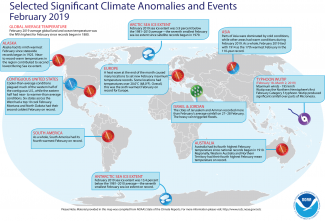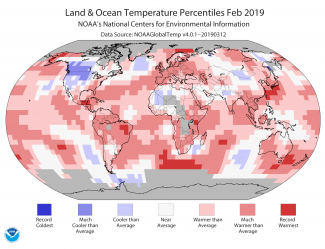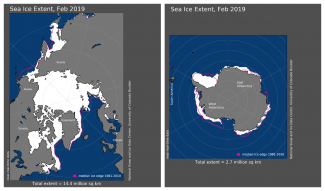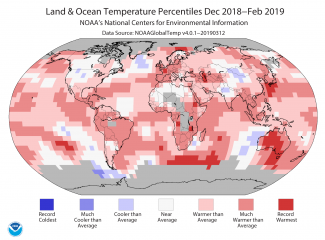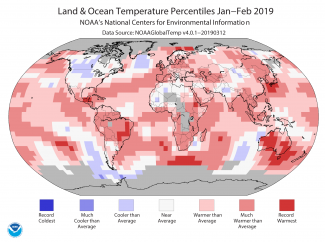Fifth warmest February on record for globe

The global land and ocean surface temperature departure from average for February 2019 was the fifth highest for the month of February in the 140-year NOAA global temperature dataset record, which dates back to 1880. The December–February and the year-to-date temperatures were both the fourth warmest such periods on record.
This monthly summary, developed by scientists at NOAA National Centers for Environmental Information, is part of the suite of climate services NOAA provides to government, business, academia and the public to support informed decision-making.
February 2019 Temperature
-
The February temperature across global land and ocean surfaces was 1.42°F above the 20th century average of 53.9°F and was the fifth highest for February in the 1880–2019 record. February 2016 is the warmest February with a global temperature at 2.18°F above average.
-
Record warmth during February was mostly limited to ocean areas, specifically across parts of the Barents Sea, the Southern Ocean off South Africa’s southern coast and off of Australia’s southeastern coast and the East China Sea. Record-warm temperatures were also observed across parts of southern Mexico, northeastern Brazil and the Indian Ocean. No land or ocean areas had record-cold February temperatures.
-
-
The February globally averaged land surface temperature was 1.87°F above the 20th century average of 37.8°F. This value was the 15th highest February land temperature in the 140-year record. However, this was the smallest (least warm) February temperature departure from average since 2014.
-
The most notable land surface temperature departures from average during February 2019 were present across much of the Northern Hemisphere. The most notable cool temperature departures from average were present across much of Canada and the contiguous U.S. as well as parts of central Asia, where temperatures were 5.4°F below average or cooler. Meanwhile, much of Alaska, Europe, central Russia and the Far East had temperatures that were 7.2°F above average or higher.
-
South America, Europe and Oceania had a February temperature that ranked among the eight warmest Februarys on record. Meanwhile, Africa and North America had their smallest (least warm) February temperature since 2014. North America was the only continent that had a February temperature that was below average.
-
The Caribbean region had a February temperature that ranked as the sixth highest February on record. Meanwhile, the Hawaiian region had its smallest (least warm) February temperature since 2013.
-
-
The February globally averaged sea surface temperature was 1.26°F above the 20th century monthly average of 60.6°F — the second highest global ocean temperature for February in the record, behind 2016 (+1.46°F). The five warmest February global ocean temperatures have occurred since 2010.
Sea Ice and Snow Cover
-
The February average Arctic sea ice extent tied with 2015 as the seventh smallest in the 41-year record at 347,000 square miles (5.9 percent) below the 1981–2010 average, according to an analysis by the National Snow and Ice Data Center using data from NOAA and NASA. During February 2019, sea ice extent retreated in the Bering Sea, while sea ice growth occurred in the Barents Sea and the Sea of Okhotsk.
-
Antarctic sea ice extent during February was 160,000 square miles (13.4 percent) below the 1981–2010 average. This was also the seventh smallest February extent on record. The Antarctic sea ice reached its annual minimum extent on February 28 and again on March 1 at 954,000 square miles — the seventh lowest minimum extent in the satellite record.
-
According to data from NOAA and analyzed by the Rutgers Global Snow Lab, the Northern Hemisphere snow cover extent during February was 170,000 square miles above the 1981–2010 average. This was slightly above average and the 23rd largest snow cover extent in the 53-year record. The North American snow cover extent was the largest since 2010 and the fourth largest on record, while the Eurasian snow cover extent was the 12th smallest on record.
Seasonal (December 2018–February 2019)
-
The December 2018–February 2019 average temperature across global land and ocean surfaces was 1.51°F above the 20th century average of 53.8°F and the fourth highest for December–February in the 1880–2019 record. The yearly global land and ocean surface temperature for the three-month season has increased at an average rate of 0.13°F per decade since 1880; however, the average rate of increase is twice as great (0.25°F per decade) since 1981.
-
Record-warm temperatures during the three-month period were present across much of Australia and its surrounding Southern Ocean as well as parts of East China and Barents Seas, the southeastern Pacific Ocean and the Southern Ocean off South Africa’s southern coast. No land or ocean areas had record-cold temperatures during December 2018–February 2019.
-
-
The globally averaged land surface temperature for December–February was 2.20°F above the 20th century average of 37.8°F. This was the eighth highest for December–February in the 140-year record.
-
The most notable warmer-than-normal land surface temperature departures from average during December 2018–February 2019 were present across much of Alaska, the southeastern contiguous U.S., central Russia, Europe, southwestern Asia, Australia and the Southern Ocean off of South Africa’s southern coast. These areas had temperature departures that were 3.6°F above average or higher. Meanwhile, the most notable cool temperature departures were present across much of Canada, the northern contiguous U.S. and central Asia, where temperatures were 2.7°F below average or cooler.
-
Oceania had its warmest December–February on record. Australia, which is part of the Oceania region, also had its warmest December–February on record. South America and Europe had a December–February temperature that ranked among the seven highest such period on record.
-
North America and Asia had their smallest (least warm) temperature departure from average for December–February since 2014. The Caribbean region also had its smallest (least warm) temperature departure from average for the three-month season since 2012 and the 10th warmest since regional records began in 1910.
-
-
The December–February globally averaged sea surface temperature was 1.26°F above the 20th century average of 60.5°F — the second highest for December–February in the record, trailing behind 2016 by 0.25°F.
Year-to-date (January–February 2019)
-
The year-to-date temperature across global land and ocean surfaces was 1.51°F above the 20th century average of 53.8°F — the fourth highest for January–February in the 140-year record.
-
The first two months of the year were characterized by warmer-than-average conditions across much of the globe’s land and ocean surface. Notable warm temperatures were present across much of Alaska, southwestern and central Asia, as well as Australia. The most notable cooler-than-average temperatures were present across much of Canada and the western half of the contiguous U.S.
-
Record-warm temperatures during the year-to-date period were present across much of Australia and its surrounding Southern Ocean as well as parts of East China and Barents Seas, the southeastern Pacific Ocean, the Southern Ocean off South Africa’s southern coast, and across parts of northeastern Brazil. No land or ocean areas had record-cold temperatures during January–February 2019.
-
-
The year-to-date globally averaged land surface temperature was 2.29°F above the 20th century average of 37.4°F. This value was the eighth highest for January–February in the record.
-
Oceania’s January–February 2019 temperature was 3.24°F above average and the highest such period since continental records began in 1910. South America had its fifth highest such period on record. However, North America had its smallest (least warm) January–February temperature departure from average since 2008.
-
The year-to-date globally averaged sea surface temperature was 1.21°F above the 20th century average of 60.6°F. This was the third highest for January–February in the 1880–2019 record.
-
Find a more complete summary of climate conditions and events for February 2019.

